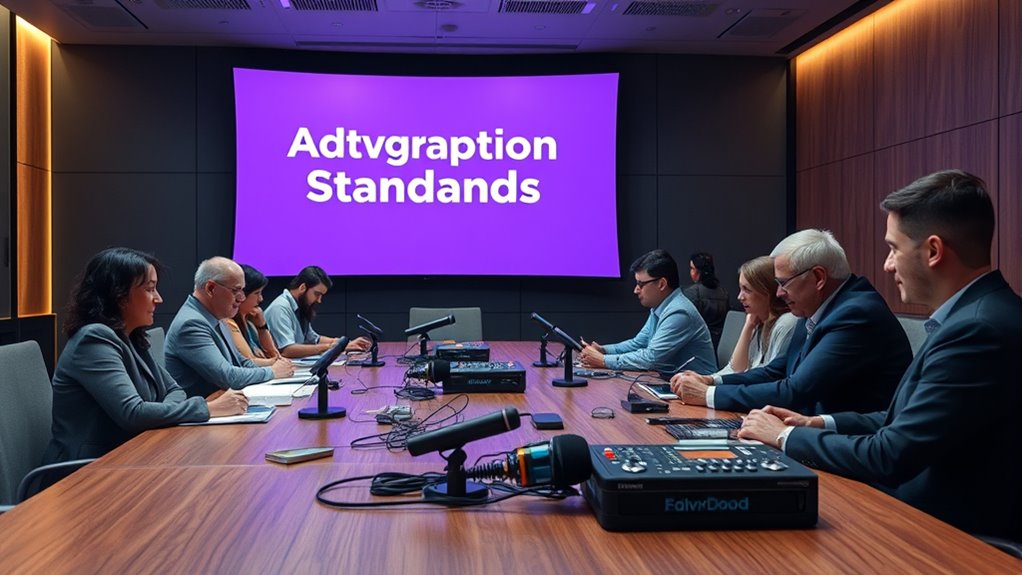To guarantee your streaming content is inclusive, follow audio-description standards that guide you to create clear, consistent, and engaging narration. Use descriptive language to paint vivid images without overwhelming viewers, and synchronize your descriptions with the visual action. Focus on conveying emotions, scene details, and character intentions naturally, all while respecting timing and flow. Mastering these standards helps make your content accessible and enjoyable for everyone—keep going to discover more essential tips.
Key Takeaways
- Follow standardized phrasing and timing guidelines to ensure clarity and predictability in descriptions.
- Synchronize audio descriptions precisely with visual actions to maintain natural flow.
- Use descriptive language that balances detail and brevity, accurately conveying scenes and emotions.
- Incorporate cues about tone, mood, and character expressions to enrich understanding.
- Adhere to accessibility standards and best practices through training and established content creation protocols.

Have you ever wondered how audio descriptions make visual content accessible to everyone? When you watch a movie or a TV show with audio descriptions, you’re experiencing more than just sounds and dialogue—you’re gaining a vivid picture of what’s happening on screen. This accessibility largely depends on effective narrative techniques and descriptive language used by describers. They craft a narrative that seamlessly integrates with the original audio, guiding you through scenes, actions, and emotions without disrupting the story’s flow. These techniques are essential because they help paint a clear mental image, making the visual elements understandable even without seeing them.
Descriptive language is the backbone of good audio descriptions. It needs to be precise yet concise, providing enough detail to evoke the scene’s atmosphere without overwhelming the listener. For example, instead of saying, “A person enters the room,” a well-crafted description might say, “A tall man with a blue jacket walks through the doorway, glancing around cautiously.” This level of detail helps you form a mental picture, understanding the character’s appearance, actions, and emotional state. The key lies in selecting the right words that balance informativeness with brevity, ensuring you’re not burdened with superfluous information but still receive enough context to grasp the scene fully.
Narrative techniques in audio descriptions involve more than just describing what’s visually apparent. They often include cues about tone, mood, and character intentions, enriching your understanding of the story. Describers might use tension-building phrases during suspenseful moments or highlight facial expressions that reveal a character’s feelings. These techniques help create a cohesive story that integrates seamlessly with the original audio track, allowing you to follow the plot and emotional beats effortlessly. By employing these methods, describers turn visual content into an auditory experience that’s just as immersive, ensuring that everyone, regardless of visual ability, can enjoy the full depth of the story.
Standards for audio descriptions emphasize consistency and clarity in applying narrative techniques and descriptive language. They guide describers to use standardized phrasing and avoid ambiguity, making the experience more predictable and accessible. Such standards also prioritize the importance of timing—ensuring descriptions are synchronized with the visual action, not too early or too late, so you can follow along naturally. When these standards are followed, they improve the overall quality of accessible content, making it more inclusive and enjoyable for all viewers. Ultimately, the careful use of narrative techniques and descriptive language underpins the entire goal of making visual storytelling accessible, allowing you to immerse yourself fully in the narrative, no matter your visual ability. Additionally, training in content creation ensures describers adhere to these standards effectively, further enhancing viewer experience.
Frequently Asked Questions
How Do Audio-Description Standards Differ Internationally?
You’ll notice that audio-description standards vary internationally due to cultural adaptations and linguistic variations. Different countries tailor descriptions to reflect local customs, humor, and idioms, making content more relatable. Language differences also impact how descriptions are crafted, with some regions prioritizing clarity and others emphasizing cultural nuances. These variations guarantee accessibility respects diverse audiences, but they can make standardization challenging across borders.
What Technology Is Used to Deliver Audio Descriptions?
Imagine a world where every movie and show speaks directly to you—thanks to innovative technology. You’ll find voice-over narration seamlessly integrated with accessibility metadata, ensuring descriptions are clear and perfectly timed. This tech uses advanced audio encoding and synchronization, making descriptions feel natural and immersive. Whether on streaming platforms or broadcast TV, these tools deliver rich, inclusive experiences, breaking down barriers so everyone can enjoy entertainment fully.
How Are Creators Trained to Produce Effective Descriptions?
You’re trained to produce effective descriptions by mastering voiceover techniques and description scripting. You learn how to convey visual details clearly and concisely, avoiding unnecessary information. Training involves practicing timing, tone, and pacing to guarantee descriptions fit seamlessly into content. You also get feedback from experts, helping you refine your skills. With these techniques, you create descriptions that enhance accessibility and provide an inclusive experience for all viewers.
What Challenges Exist in Standardizing Audio Description Globally?
You might think standardizing audio description globally is simple, but cultural diversity and linguistic barriers challenge that idea. Different regions have unique storytelling styles and language nuances, making it hard to create universal standards. These differences can lead to inconsistent experiences for viewers worldwide. Overcoming these challenges requires collaboration, adaptable guidelines, and sensitivity to diverse cultures, ensuring that everyone, regardless of location, enjoys inclusive and effective audio descriptions.
How Do Audio-Description Standards Evolve With New Streaming Platforms?
When new streaming platforms emerge, you’ll see audio-description standards evolve through updates to voice-over narration and descriptive metadata. Developers and content creators work together to guarantee descriptions stay clear, accurate, and accessible. As technology advances, you can expect standards to adapt, incorporating better audio quality and integration of descriptive metadata. This ongoing process helps make streaming content more inclusive, ensuring that everyone, including those with visual impairments, can enjoy the experience fully.
Conclusion
By understanding audio-description standards, you can guarantee accessibility, enhance experiences, and promote inclusion. By applying clear guidelines, embracing consistency, and prioritizing viewer needs, you make streaming more welcoming. By advocating for quality, supporting best practices, and fostering awareness, you contribute to a more equitable digital world. Together, through these standards, you create content that’s not just watched, but truly enjoyed by everyone, because accessibility starts with you.








